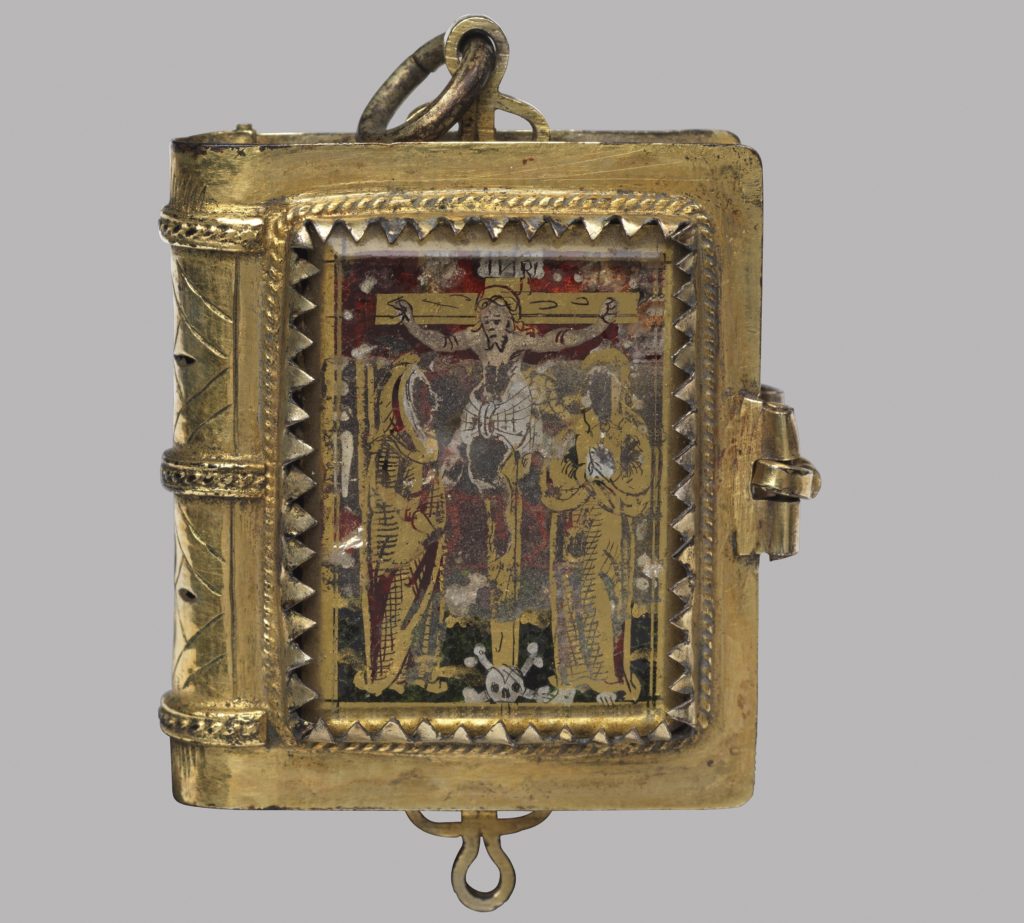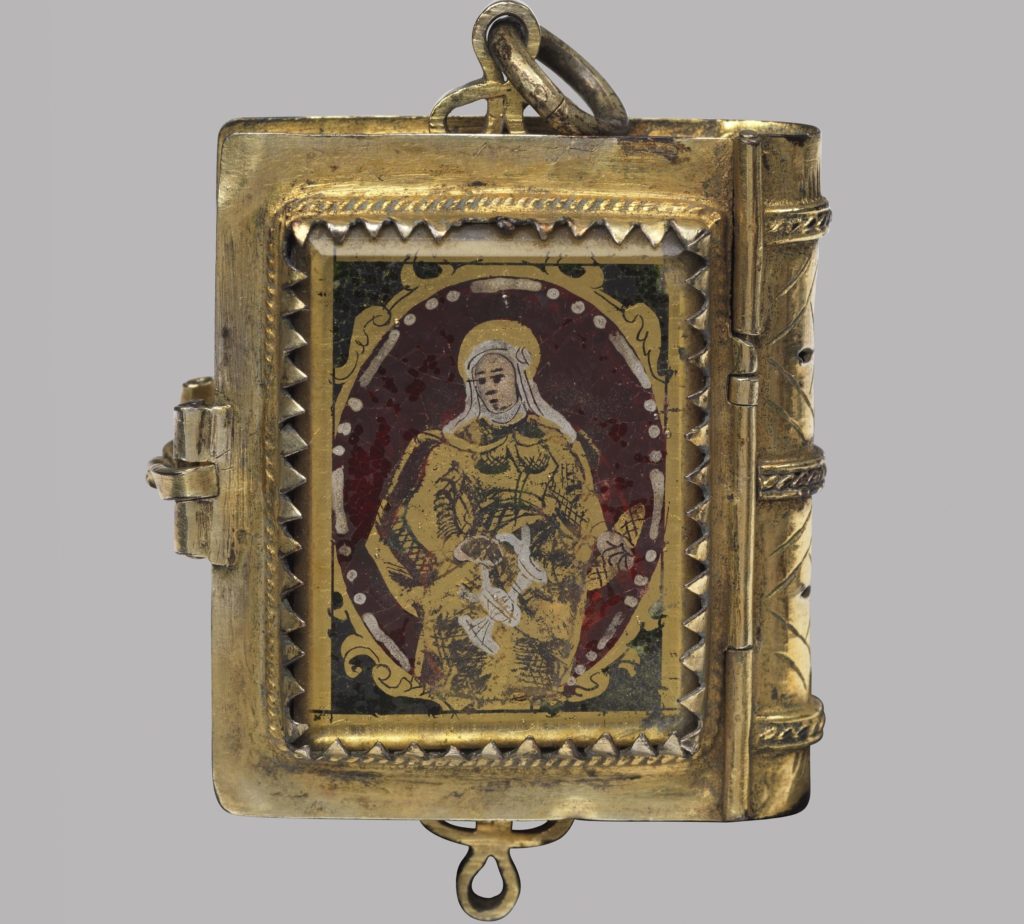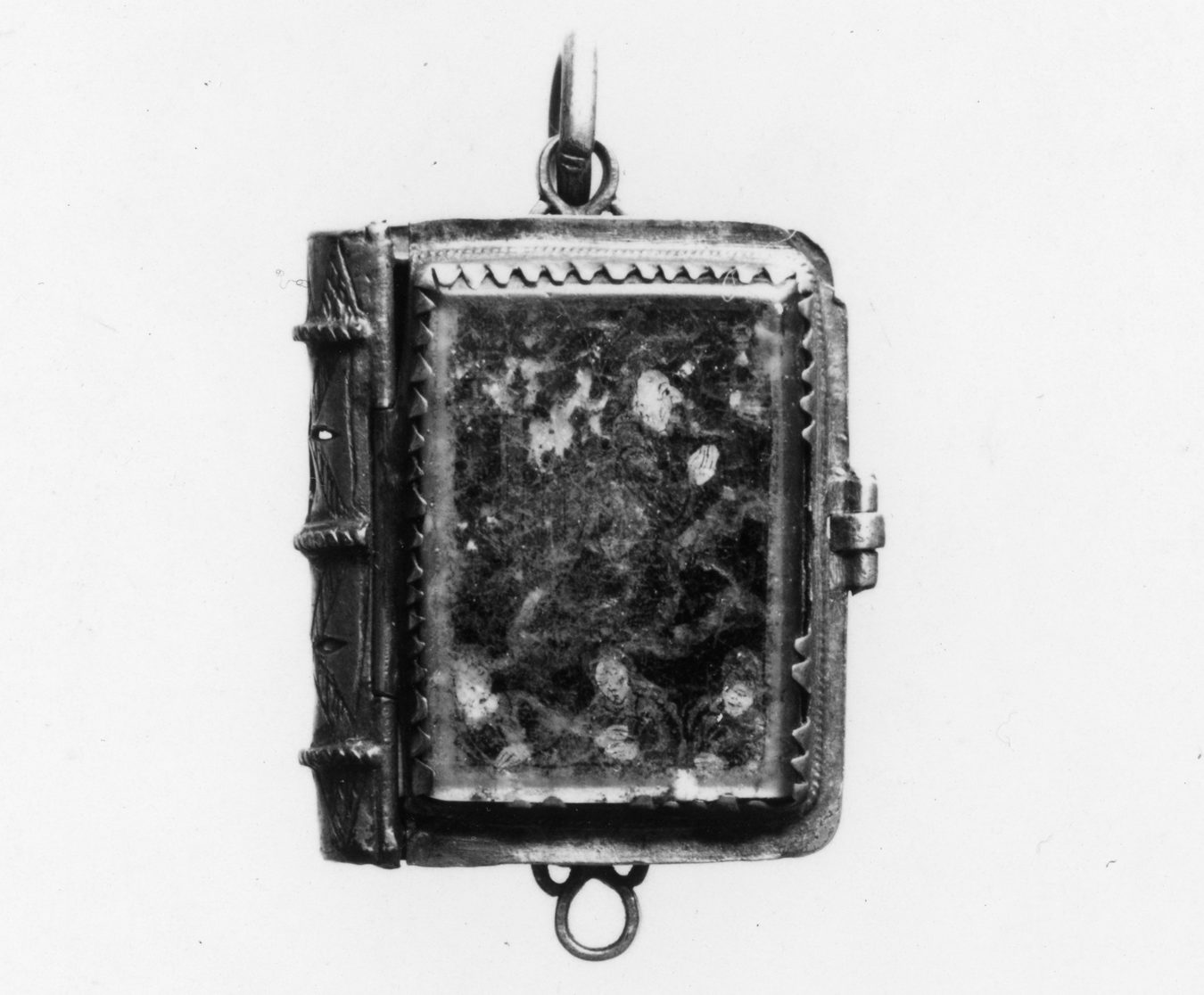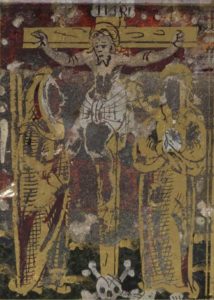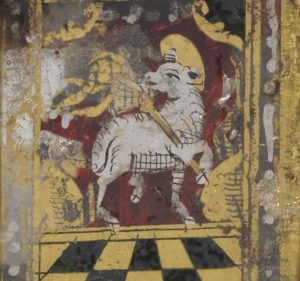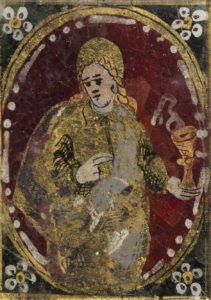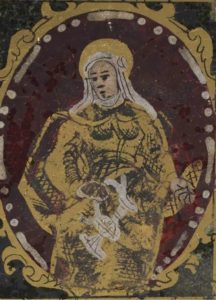Devon Abts, a PhD candidate in Theology at King’s College London, takes a close look at an unusual early seventeenth-century pendant. Initially, the object might have been a reliquary. But the significance of its origins and iconography has endured for generations. How might the Victorian collector Thomas Gambier Parry (1816–1888) have felt when this pendant landed in his lap?
The pendant was on display between 13 November 2015 and 15 March 2016, in The Courtauld Gallery.
Measuring just 3.2 cm in height and 2.8 cm in width, this tiny pendant is more mysterious than an initial study would suggest. Reverse-painted glass panels are decorated with religious images and set into a silver-gilt mount shaped like a book, which can be ‘opened’ like a locket to reveal an empty inner container.
On the top and bottom are matching trefoil (shaped like three overlapping rings) loops, and the ‘book’ is held shut by a clasp on one side. All of this we can readily observe. But then the questions start building: when and where was the pendant made? What is depicted in each of the glass panels? And what would have been kept inside this unusual object?
Locating the Pendant
When and where was this pendant made? It would appear that both the glass and silver-gilt mount date to the end of the Renaissance. The glass panels are reverse-painted (a technique known today by the French name, verre églomisé [1]) and resemble German or Italian examples from the early seventeenth century. Pendants in the shape of books were fashionable during the Renaissance, especially in the sixteenth century.[2] The Fitzwilliam Museum in Cambridge has in its collection one such example.
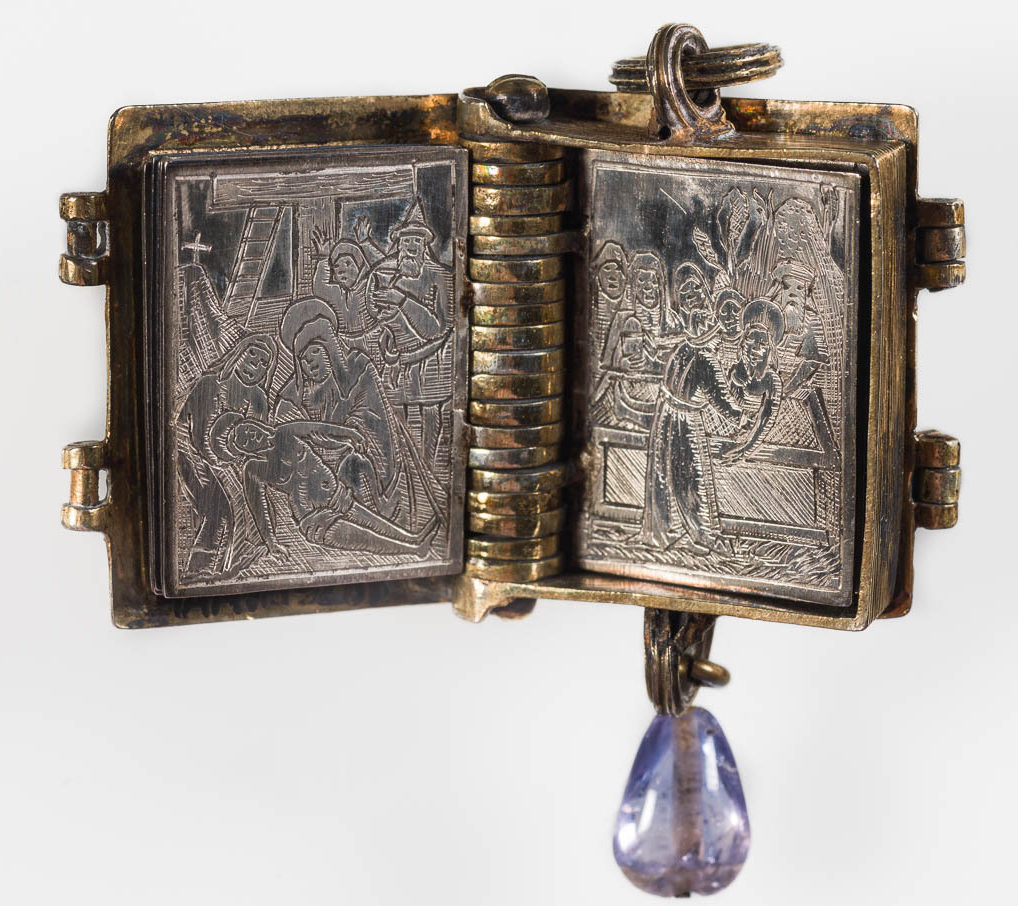
The earliest record that we have for the Courtauld pendant dates to 1871, when the collector Thomas Gambier Parry (1816–1888) seems to have acquired it. Is it a coincidence that the Victoria and Albert Museum (V&A) purchased, in that same year, a remarkably similar pendant from a dealer in Nuremberg?

The similarity between the two pieces raises questions surrounding their production. Could seventeenth-century glass and metalwork components have been repurposed and combined during the Victorian period to produce the pendants at The Courtauld and the V&A?
One Design, Many Pendants
A young German art historian[3] has recently identified eight book-shaped pendants with strikingly similar features, including the objects in both the Courtauld and the V&A collections. Each of these eight pendants is composed of four reverse-painted panels set in a book-shaped silver-gilt frame. The details are virtually identical in nearly all of them, and most are tentatively dated to the early 1600s.
On The Courtauld’s piece, the glass is almost certainly seventeenth-century work, but the mounts are more difficult to date and the question of their making is unclear.
Until now, the only scholarly publication on these particular pendants is an article from 1942 by Robert Forrer.[4] The author speculates that the pendants could initially have been made as metal frames into which the purchaser would have inserted glass panels that depicted subjects of their choice. However, as noted above, we cannot ignore the possibility that seventeenth-century glass panels from one object have been reintegrated into new mounts at a later date.
Exploring the Pendant: Iconography and Possible Uses
The iconography of the pendant opens up a further trail of discovery. What are the images depicted in the glass panels? How are they related to one another? Do they provide any clues as to how this pendant would have been used or worn by its original owner?
As mentioned above, there are four reverse-painted glass panels set on the back and front of The Courtauld’s pendant. On the front cover is an image of the Crucifixion, with Christ at its centre flanked by the Virgin Mary and John the Evangelist.
The inside left panel depicts the Lamb of God (or Agnus Dei). The ‘sacrificial lamb’ is an ancient symbol for Christ, whose death atones for the sins of the world. The lamb holds a resurrection banner, a common means of evoking Christ’s triumph over death. The placement of this inside panel directly behind the Crucifixion creates a narrative link between the two images, leading us from death to resurrection.
The third panel, located on the inner right side of the pendant, shows a haloed man holding a cup with an indistinct white shape rising from within it. Closer inspection reveals that the figure is St John the Evangelist, while the peculiar shape is a serpent. An apocryphal story of St John holds that he survived an attempt on his life through blessing his poisoned chalice and thus drawing out its venom in the form of a snake.
The image on the back panel is more enigmatic. It appears to be Mary Magdalene with an alabaster jar. Mary Magdalene, like John the Evangelist, was beloved of Christ and a witness to the resurrection. However, the elongated jug in her hand differs from the usual ointment jar associated with the Magdalene, and her simple headdress departs clearly from the long hair that usually defines her. While these inconsistencies are present, there is no symbol linking this figure to an alternative saint. We can conclude that the woman is probably Mary Magdalene, but for now the jury is out.
Without a clear sense of its origins, it is difficult to know what would have been kept inside this pendant. It was most likely a reliquary, and may have contained a prayer, a tiny codex, or a small wax seal of the Lamb of God, blessed by the Pope.
The contents of the pendant must surely relate to how it was used. Was it worn as jewellery? Or would it have hung in a chapel? Could the pendant have been a decorative attachment to a rosary? The answers to these questions continue to slip between our fingers, and the function of this miniature object remains a mystery.

Thomas Gambier Parry (1816–1888): High Church Collector & Artist
Thomas Gambier Parry is the first recorded owner of the Courtauld’s pendant. He was a Victorian gentleman of enormous energy who used his wealth to explore the world, educate himself, and better the lives of others. He was a philanthropist, amateur artist, and author—but he is perhaps best remembered as a discerning collector. Gambier Parry built a formidable collection of medieval and Renaissance fine and decorative art. His aesthetic sensibilities were deeply influenced by strong religious convictions: he was an Anglo-Catholic and a committed churchgoer who actively engaged in Church-related debates of his day. Gambier Parry’s collection of sacred art bears witness to a man whose love of the beautiful was intertwined with his devotion to the sacred.
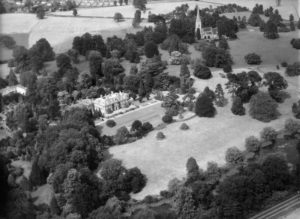
Gambier Parry’s family earned their wealth as directors of the East India Trading Company. Both his parents died before he was five years old, leaving him in the care of his mother’s relatives. Gambier Parry was educated at Eton and Cambridge. In 1838, he purchased Highnam Court, an estate in Gloucestershire, where he lived for the rest of his life. But Gambier Parry was no idle country gentleman. He travelled extensively across Europe, both with his first wife Isabella (1821–48) and later with his second wife, Ethelinda (c.1827–96), building an impressive collection of art, and refining his aesthetic sensibilities.
In 1851, Gambier Parry commissioned his friend, the High Church architect Henry Woodyer (1816–96), to build a lavish church on his estate. He decorated the interior himself using an original painting technique he called ‘Spirit Fresco’. He later published both a manual on this method, as well as a treatise on his aesthetic views. In addition to these artistic pursuits, Gambier Parry devoted himself to philanthropy, founding and funding an orphanage, a school, and a children’s hospital. After suffering a fatal heart attack, he was buried at Highnam Church. He was succeeded by six children, the youngest of whom was the notable composer, Sir Hubert Parry (1848–1918).
‘We Anglo-Catholics’: Gambier Parry & the Victorian Church
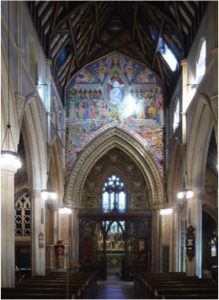
One of the most significant religious developments in Victorian England was the rise of Anglo-Catholicism, a movement among High Church Anglicans that sought to reconnect the English Church with its traditional roots. Anglo-Catholicism emerged in the 1830s and spread rapidly, particularly in well-educated circles. With renewed interest in ecclesial tradition, High Church Anglicans eventually began to revive ornate liturgical practices that had been abandoned during the Reformation. This paved the way for the development of materially rich forms of worship within Anglicanism. The beauty and ritual of the movement greatly appealed to Gambier Parry. However, he had little interest in the study of doctrine, and his faith was emotional rather than intellectual. Gambier Parry’s idealism is captured in a journal entry of 1852, in which he describes religion as, ‘simple expression of feeling… undisturbed by the mere outward appearances of actual historical fact.’
Gambier Parry & Ecclesiology
Gambier Parry’s religious sensibilities aligned with Ecclesiology, a movement in High Church Anglicanism that promoted the restoration of English churches according to Gothic architectural principles. He was an active member of its leading association (the Cambridge Camden Society, later renamed the Ecclesiological Society) throughout most of his life. Like many members of the Society, his faith was fueled by his passion for architecture, and in his journals, he often reflected upon the spiritual power of the churches he visited while travelling. For example, in May 1851, he described the Cathedral in Milan as an emblem of the ideal of Christian hospitality: ‘…stretching its arms north, south, east and west, it calls all the neighbouring Christians to meet together beneath its wide spread roof, and offers to them… an emblem of unity and peace.’
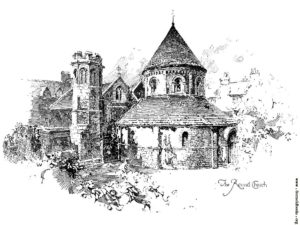
Holy Innocents: Gambier Parry’s Legacy of Faith
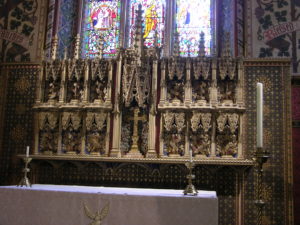
Gambier Parry’s religious idealism is perhaps best memorialized in the church he commissioned to be built on his estate at Highnam, which he considered to be his greatest legacy. Holy Innocents was designed according to Ecclesiological principles and extravagantly decorated with colourful frescos and stained glass windows. Following the consecration of Holy Innocents in 1851, Gambier Parry wrote in his journal, ‘Whatever is good is God’s doing. It is an awful privilege to be even ever so mean an instrument for good in His hands.’
The Ministry of Art: Thomas Gambier Parry on Devotion Through the Arts
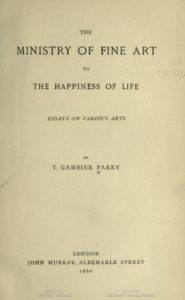
Gambier Parry’s publication on his aesthetic views – titled The Ministry of Fine Art to the Happiness of Life – provides some insight into his understanding of the relationship between art and faith. While the essays provide an interesting glimpse into the mind of a nineteenth-century aesthete, Gambier Parry’s efforts produced neither an original, rigorous argument, nor a masterpiece of Victorian prose (the tone of his treatise is highly florid). However, the work does reveal his belief that beauty provides a bridge from this world to the next, and that art both educates us about, and connects us to, the Divine.
Beauty & Idealism
‘The purpose of the Fine Arts is the expression of beauty’, Gambier Parry asserts at the outset of his treatise. In his view, beauty found in the world around us is always, ‘the symbol of that Divine light which illuminates both [nature] and [men].’ Gambier Parry ascribed to an idealist understanding of beauty: he believed that material forms of beauty are inferior the expression of the immaterial, inscrutable beauty of God. Beauty, he writes: ‘speaks, calls, appeals to him from and for a higher life than that of sense…’
‘Art is the Chorus of Universal Praise’
Throughout The Ministry of Fine Art, Gambier Parry expresses his conviction that art aids contemplation and enriches our spiritual life. In his chapter on sacred architecture, he proclaims, ‘Art is the chorus of universal praise’, and explains his belief that art and architecture can vitalize worship. And elsewhere, Gambier Parry writes that religious art is, ‘…an aid to the weak, a delight to the strong, a store unfailing for art to use, to adorn not walls alone but minds, with thoughts of what is highest, noblest, loveliest, that the blessed God had spread along the path of life, to lead them upward to Himself’. Here again, we can see his idealism: art leads us up from our path in this life toward what is ‘highest, noblest, [and] loveliest’ — in essence, toward God.
The Book-Shaped Pendant in Thomas Gambier Parry’s Collection
It would appear that Gambier Parry most likely acquired his pendant in 1871.
He scrawled this date on the back of an envelope along with the following description:
A delicate specimen of painting & gilding on crystal. A locket in the form of a Book.
Inside it are painted the subjects of the Lamb of God – and St John
Outside the crucifixion, and Mary Magdalene holding the alabaster vase in her hand.
Paid £2.00 for it
Was there a devotional reason for his interest in the pendant? It is quite unlikely that he would have worn it, but would he have kept this object somewhere personal like a bedside table, or hung it in a chapel? While we cannot answer these questions with certainty, we can surmise a few possible reasons why the collector felt drawn to this beautiful pendant.
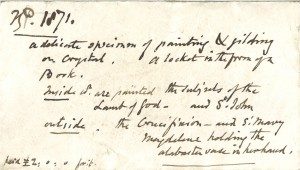
Gambier Parry on the Art of Glass Painting
Gambier Parry devotes an entire chapter his book, The Ministry of Fine Arts to the Happiness of Life, to the subject of stained glass art. He felt that painting on glass was a difficult and noble artistic endeavor, ‘…with its own laws, its own powers, its own limits; …it is light that has to be dealt with, not shadow; translucent glass, not solid canvas; open air, not a picture-frame…’ Could the glass panels have reminded him of the stained-glass windows that he so admired in the great Gothic cathedrals of Europe?
A Protestant-Catholic Fusion
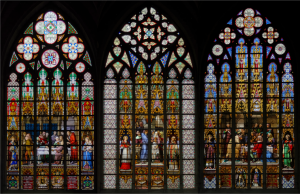
Gambier Parry may have been drawn to this object for its pleasing book shape. He was a well-educated man with an insatiable thirst for knowledge, and the book may have inspired him. But the book also suggests more than this: the Bible is a symbol of the ideals of the Protestant Reformation, when the Scriptures were translated into vernacular and made available to all. Yet the iconographic decoration of this book resonates with a Counter-Reformation appreciation for art and beauty. We might say that the pendant fuses Protestant ideals and Catholic aesthetics, which would have suggested a meaningful emblem for the Anglo-Catholic collector’s own religious identity.
References and Acknowledgements
[1] The term ‘verre églomisé’ would not have been used during the Renaissance, as the now-popular French name was not coined until the eighteenth century. [2] Ebenhoech, Romina, and Silke Tammen. ‘Wearing Devotional Books’ [Unpublished Manuscript]. As Ms. Ebenhoech points out in her paper, there are no known extant examples of book-shaped pendants prior to the middle of the sixteenth century, as this kind of jewellery seems to have become suddenly popular starting around 1500. [3] Ebenhoech, Romina. (2015, September-October). [Email correspondence and in-person dialogue]. [4] Forrer, Robert. ‘Silberne Zier-Anhänger in Buchform aus der Zeit der Renaissance’, Pro Arte, 1(6) (1942): 5–8.I wish to thank the following scholars for their help:
- Kirstin Kennedy, Curator of Metalwork at the Victoria and Albert Museum, for taking time to show us similar objects in the V&A collection, and for sharing her insight on our object.
- Romina Ebenhoech, PhD candidate in art history at the University of Giessen, Germany, for generously sharing her original and very helpful research on, and images of, book-shaped pendants of the Renaissance. (Ms. Ebenhoech’s provisional thesis title is “Bücher tragen. Miniaturbuchanhänger des 15. und 16. Jahrhunderts. Schmückende Pretiosen, Bücher, Miniaturen und Medien der Andacht.“)
- Ayla Lepine, for aiding with the selection of this object.

